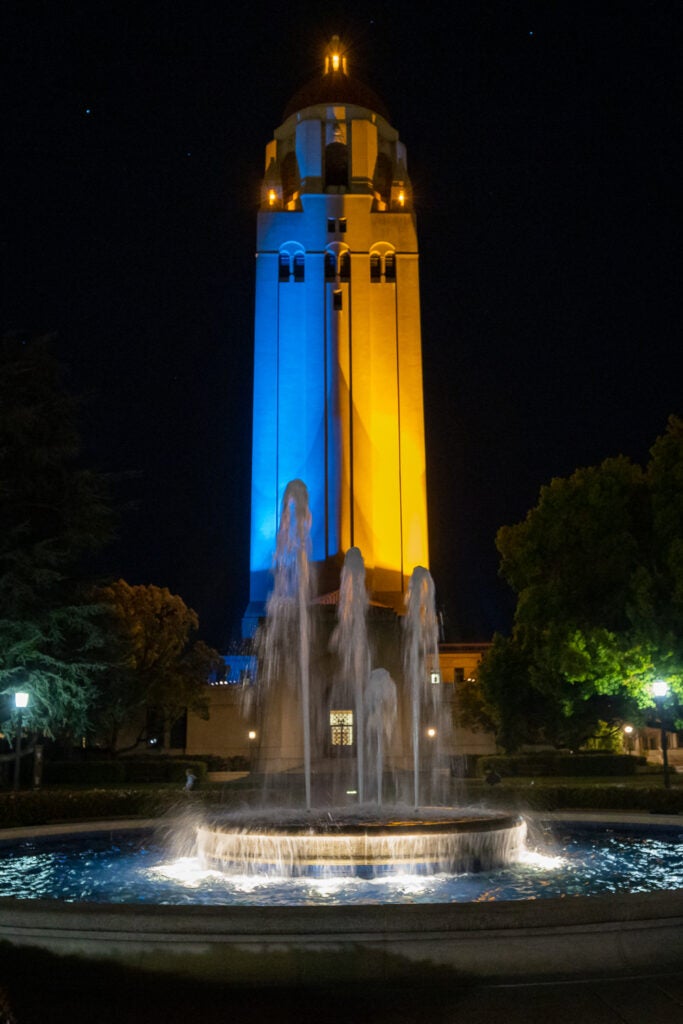Stanford’s Hoover Tower lights up yellow and blue in support of Ukraine
On Friday, Stanford’s iconic Hoover Tower lit up in the blue and yellow colors of the Ukrainian flag in a show of solidarity with the country and its people.
The blue and yellow colors of the Ukrainian flag glowed brightly from the 285-foot Hoover Tower on Friday evening in an unprecedented show of support for the country invaded by Russia in recent weeks.

Stanford’s iconic Hoover Tower lit up in the blue and yellow colors of the Ukrainian flag in a show of solidarity with the country and its people. (Image credit: Kurt Hickman)
“The Hoover Library and Archives houses books and archival collections chronicling historical struggles for freedom, and it has long been a beacon for Russian, Ukrainian and Soviet dissidents,” Condoleezza Rice, the Tad and Dianne Taube Director of the Hoover Institution, wrote in an email to colleagues Friday.
The iconic tower swathed in yellow and blue on Stanford’s campus Friday was meant to remind the community of the “hope that resides in the hearts of free peoples,” the lives lost and hope for a peaceful outcome to the unfolding tragedy, Rice wrote.
It is policy not to use tower illumination to mark catastrophic world events, since there would “sadly be too many to accommodate,” Rice added. However, after consultation with President Marc Tessier-Lavigne, they agreed it would be appropriate in this case, “because of the special place of Ukraine in Hoover’s history, together with the world-shattering nature and scale of this unprovoked war of aggression, and the breathtaking assault it represents on the democratic order, which Hoover, in its founding mission seeks to safeguard.”
Hoover Tower was built to house the 31st U.S. president’s collection of historical records.
In 1959, Herbert Hoover, a member of Stanford’s Pioneer Class, wrote that its mission is “from its records, to recall the voice of experience against the makings of war, and by the study of these records and their publication, to recall man’s endeavors to make and preserve peace.”
On the bourdon, the largest of the bells in Hoover Tower, a Latin inscription reads, “Una pro pace sono,” or “For peace alone do I ring.”
Rice also shared links to the Hoover Institution Library and Archives which houses many collections relating to the Ukrainian struggle for freedom throughout the Soviet period and on the development of democracy during its years of independence. These include the massive Ukrainian subject collection, a large portion of which deals with the development of Ukrainian democracy from 1990 through the present day and includes important resources on the origins of the present war. There were also links to collections on the struggle for democracy and human rights in Russia and the Soviet Union.
“As Americans, we know all too well that the road to freedom is long and it is hard,” Rice wrote. “The people of Ukraine have reminded us of how fragile freedom can be, that we must not take it for granted and that it is worth fighting for.”
In recent weeks, Tessier-Lavigne has repeatedly expressed the university’s support for all community members affected by these events. He also has encouraged community members to reach out as needed to the Bechtel International Center, the university’s mental health resources, mentors, professors and resident advisors.